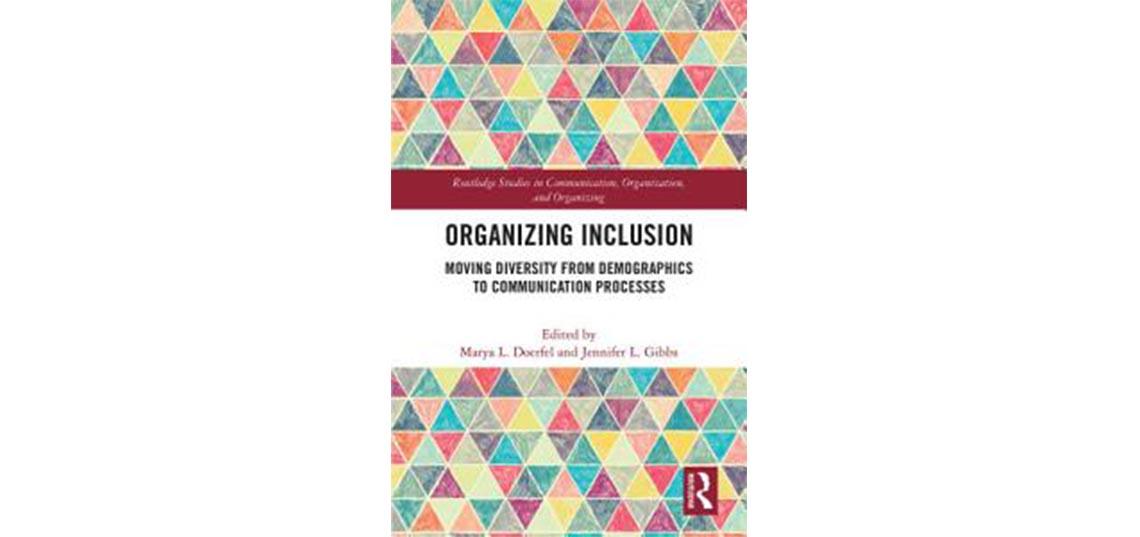
How is systemic racism embedded and perpetuated in organizations, institutions, and communities? A new book, “Organizing Inclusion: Moving Diversity from Demographics to Communication Processes” explores the ways communication as an “organizing phenomenon underlies systemic and institutionalized biases and generates practices that privilege certain groups while excluding or marginalizing others.”
Published by Routledge, the book is edited by Professor Marya Doerfel and Jennifer Gibbs, a former SC&I faculty member in the Department of Communication (from 2004 – 2016) who is now Professor of Communication at the University of California, Santa Barbara.
“The most important takeaway from the book is that we need to move the diversity conversation forward by going beyond demographics to understanding how inclusion and exclusion are organized through communication practices,” Doerfel and Gibbs said. “This involves changing existing structures and systems of communication. ‘Having’ diversity is different from ‘doing’ inclusion. We follow other scholars’ lead in addressing how we can hire diverse workforces, but we also need inclusive and equitable communication, where marginalized groups can have a meaningful voice and participation in such systems. Asking diverse employees to ‘just go with the flow’ or ‘blend in’ is asking them to silence their unique perspectives. The chapters in our book examine how organizations and those who work within them perpetuate or interrupt such systems.”
The book explores how these communication practices also occur in academia, specifically in sub-disciplines of communication studies, represented by divisions of professional associations like the National Communication Association. Topics also range from social and environmental activism to problems of race, gender, sexual orientation, age, and ability.
“Some of our contributors have built their careers on addressing diversity, stigma, minoritized groups, inequalities, racism, sexism, colonialism, homophobia, and other institutionalized biases that are pervasive in groups, businesses and organizations, and society as a whole,” Doerfel said. “Other contributors care about these issues deeply, though their careers have been driven by other human communication phenomena. Both types of scholars were excited about taking the time to think more deeply about the organizational communication processes that can perpetuate or disrupt systems that marginalize.”
Doerfel explained that the idea for the book grew out years of friendship and scholarly interactions she and Gibbs have had with faculty colleagues and students at both Rutgers and UC Santa Barbara.
“Even though Dr. Gibbs has since moved, our professional life in the communication field and especially in the School of Communication and Information has been enriched by colleagues and students who have a wide range of intellectual, methodological, and life experiences. In conversations within the SC&I community and through deep friendships we have built with interdisciplinary scholars here at Rutgers, at UC Santa Barbara where Dr. Gibbs now works, and through other colleagues in academia and industry, we realized the importance of challenging our particular area of communication – organizational communication – and ourselves, with critical self-examination.
“In spirited conversations, debates and reading, we learned that a shortcoming of our discipline and those of us who work in it is that diversity is often seen as its own ‘separate’ topic when in fact, all aspects of communication generate systems that marginalize. Indeed, there has been an awakening in academia at-large and across other industries about the ways in which academic as well as societal norms and systems have a limited view. White supremacy is ‘baked in’ to the very fiber of our thinking. Our colleagues and students helped us think through how this book can add to that conversation. In this way, our book challenges all of us to rethink our own role in perpetuating racist systems and how we can change that with both individual-level and structural change.”
The book, Doerfel said, went to press just before the recent groundswell of activism that has provided a tipping point for citizens and employers alike in heightening interest in how to better address inequality. Because our contributors theoretically address the various ways in which exclusion is organized, practitioners and scholars alike will gain deep insights into how to interrupt such problems in their own workplaces and in their scholarship, respectively.
This book will be of great relevance to organizational stakeholders, human resource personnel and policy makers, as well as to scholars and students working in the fields of communication, management, and organization studies and is available here.
Discover more about the Communication Department at the Rutgers School of Communication and Information (SC&I) on the website.
